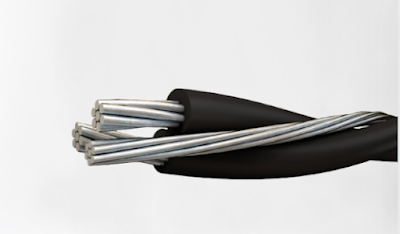Difference Between MV Cable and HV Cable
Introduction
The selection of cables is an essential component in the safe and effective delivery of electricity in the field of electrical power transmission and distribution. Electrical power can be transmitted and distributed at different voltage levels using two common types of cables: medium voltage (MV) cables and high voltage cables. Despite having comparable functions, the two types of cables have unique features and are made to work in particular ways. These are the main distinctions between medium voltage (MV) and high voltage (HV) cables, along with information on their construction, applications, voltage ratings, and other factors.
1. Voltage Ratings:
One of the primary distinctions between medium voltage (MV) cables and high voltage (HV) cables lies in their voltage ratings:Medium Voltage (MV) Cables: Medium voltage cables are designed to operate within a voltage range typically between 1 kV (1000 volts) and 36 kV (36,000 volts). These cables are commonly used for distributing electricity from substations to industrial facilities, commercial buildings, residential areas, and other low to medium voltage applications.
High Voltage (HV) Cables: High voltage cables, on the other hand, are designed to operate at voltage levels exceeding 36 kV (36,000 volts). These cables are used for long distance transmission of electricity at high voltages, typically ranging from 66 kV to 400 kV or even higher. HV cables are often employed in grid networks, interconnectors, and transmission lines to transmit bulk power over large distances with minimal losses.
2. Construction:
Medium voltage (MV) cables and high voltage (HV) cables are constructed differently to withstand the electrical stresses associated with their respective voltage levels:
Medium Voltage (MV) Cables: MV cables typically consist of multiple insulated conductors housed within a single cable assembly. The conductors are insulated with materials such as crosslinked polyethylene (XLPE) or ethylene propylene rubber (EPR) to provide electrical insulation and protection against environmental factors. Medium voltage cables may have a single core or multicore design, depending on the application requirements.
High Voltage (HV) Cables: HV cables are designed to handle much higher electrical stresses compared to MV cables. They often feature a layered construction with multiple insulation layers, shielding, and metallic armor for enhanced mechanical strength and electrical performance. The insulation materials used in HV cables are designed to withstand high electric field strengths and prevent corona discharge, partial discharge, and insulation breakdown at high voltages.
3. Insulation Materials:
Insulation materials play a crucial role in determining the electrical performance and reliability of cables, especially at higher voltage levels:Medium Voltage (MV) Cables: Common insulation materials used in MV cables include crosslinked polyethylene (XLPE) and ethylene propylene rubber (EPR). These materials offer good electrical properties, thermal stability, and resistance to moisture and environmental degradation. XLPE is particularly favored for its low dielectric loss, high breakdown strength, and excellent thermal aging characteristics, making it suitable for medium voltage applications.
High Voltage (HV) Cables: HV cables require insulation materials capable of withstanding higher electric field strengths and voltage gradients. In addition to XLPE and EPR, HV cables may utilize other advanced insulation materials such as paper impregnated oil, polyethylene (PE), or ethylene vinyl acetate (EVA). These materials provide superior dielectric properties, thermal stability, and resistance to partial discharge, corona effects, and moisture ingress, ensuring reliable insulation performance at high voltage levels.
4. Transmission Losses:
Another significant difference between MV cables and HV cables is their impact on transmission losses and system efficiency:Medium Voltage (MV) Cables: MV cables typically have lower transmission losses compared to HV cables due to their lower operating voltages and shorter transmission distances. While MV cable systems may still experience resistive losses and dielectric losses, these losses are relatively small and can be minimized through proper cable sizing, voltage regulation, and system design.
High Voltage (HV) Cables: HV cables exhibit higher transmission losses compared to MV cables, primarily due to the higher voltages and longer transmission distances involved. The higher electric field strengths in HV cables result in increased resistive losses, dielectric losses, and charging currents, leading to greater power dissipation along the cable length. To mitigate transmission losses in HV cable systems, engineers may employ techniques such as reactive compensation, voltage regulation, and efficient cable design to optimize system efficiency and minimize energy losses.
5. Environmental Considerations:
Both MV cables and HV cables are subject to various environmental factors that can affect their performance and longevity:Medium Voltage (MV) Cables: MV cables are designed to withstand a wide range of environmental conditions, including temperature variations, moisture, chemical exposure, and mechanical stresses. Depending on the application and installation environment, MV cables may require additional protective measures such as UV resistant jackets, corrosion resistant materials, and flame retardant coatings to ensure long term reliability and safety.
High Voltage (HV) Cables: HV cables face similar environmental challenges as MV cables but may be subject to higher levels of electrical, thermal, and mechanical stresses. Environmental factors such as temperature gradients, humidity, pollution, and thermal cycling can impact the insulation performance and aging characteristics of HV cables over time. To mitigate these effects, HV cables may incorporate advanced insulation materials, moisture barriers, and metallic shielding layers to enhance environmental resistance and ensure extended service life in harsh operating conditions.




Comments
Post a Comment